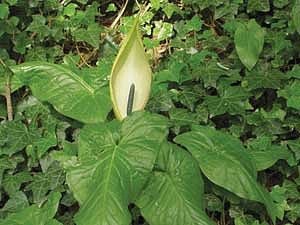July 2017 - Sussex Wildlife Trudst - Mine's a Pint
July 23rd, 2017 Let me see. I’ve written about cuckoos and cuckoo spit.
Let me see. I’ve written about cuckoos and cuckoo spit.What’s next? Ah, Arum maculatum or cuckoo pint; the most evil plant in the British Isles. Never mind its highly toxic berries, this plant has the power to steer the most pure-thinking botanist down the path to innuendo and obscenity. It’s a tiny hybrid of Benny Hill and a triffid hiding in the hedgerow.
Each spring a most bizarre plant appears in our countryside. Above shiny, speckled, trowel-shaped leaves arises a pale hood (the spathe). The spathe cloaks a purple poker-shaped flower-head (the spadix). This structure is a stinking beacon which gives off that sweet smell of decay so irresistible to insects.
Flies are hypnotically drawn into the plant and are imprisoned by stiff bristles forcing them deep inside the hood where they pollinate the female flowers. After this pollination the male flowers develop, coating the insects with their pollen before the guard bristles wilt, releasing their prisoners to pollinate another plant. In the autumn the pale hood drops to reveal the fertilised female flowers which have now developed into striking orange and red berries; a poisonous, lumpy lollypop.
What is even more fascinating than this complex performance is the huge array of common colloquial names that have been given to this plant. A few refer to its unusual appearance; ‘parson in the pulpit’, ‘soldier in the sentry box’ – but it seems that most people when they are confronted with the plant see something altogether more obscene.
Over the centuries botanists have stared at this floral Rorschach test and have likened the appearance of its reproductive structures to our own and the plant has earned itself a lewd lexicon of local names. ‘mens and womens’, ‘Adam and Eve’, ‘cows and bulls’ - names which have all given rise to its most commonly known title; ‘Lords and Ladies’.
I wonder how many people use this name not knowing that they have been lured in by the plant’s vulgar charms? There are plenty of other ‘colourful’ titles for this plant too – some not befitting a classy publication such as this parish magazine (although I wonder if ‘Willy Lily’ gets past the editor?).
I’m just proud that I haven’t been perverted by this plant. I’ve always referred to it as cuckoo pint – a wonderful evocative name, recalling the proud, lustful cry of the cuckoo and pint which means, well, I’m not sure.
Strangely I’ve always pronounced it as ‘pint’ to rhyme with ‘squint’ not pint as in ‘of Harveys’. I wonder why? Ah, here it is. “Pint. An abbreviation of the Old English vulgar slang word pintle meaning……”. Oh crikey!
by Michael Blencowe of the Sussex Wildlife Trust.
www.sussexwildlifetrust.org.uk
Sussex Wildlife Trust is a registered charity caring for wildlife and habitats throughout Sussex. Founded in 1961, we have worked with local people for over half a century to make Sussex richer in wildlife. We rely on the support of our members to help protect our rich natural heritage.
Please consider supporting our work. As a member you will be invited to join Michael Blencowe on our regular wildlife walks and also enjoy free events, discounts on wildlife courses, Wildlife magazine and our guide book, Discovering Wildlife in Sussex. It’s easy to join online at www.sussexwildlifetrust.org.uk/join or by phone on 01273 497532.
Picture: Lords and Ladies©Neil Fletcher Sussex Wildlife Trust
Comments (0)
No comments have been submitted yet.Why not be the first to send us your thoughts
Leave A Comment
Thank you for your comments, they will appear shortly once approved.
Recent Posts
Have You Seen...






